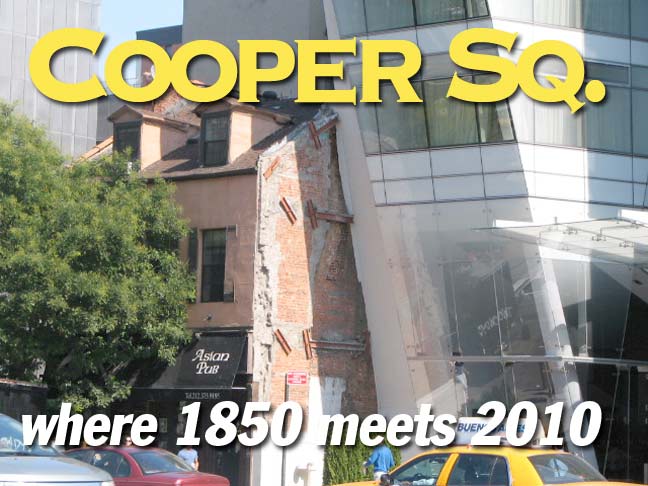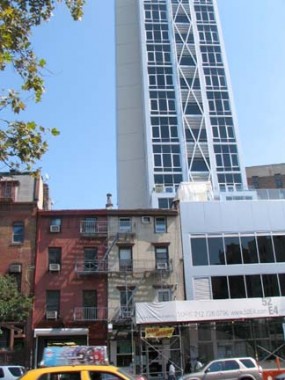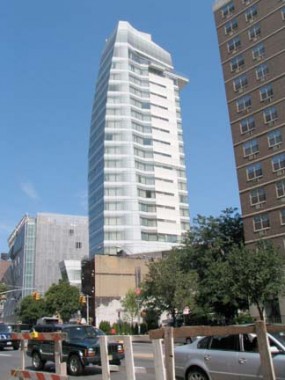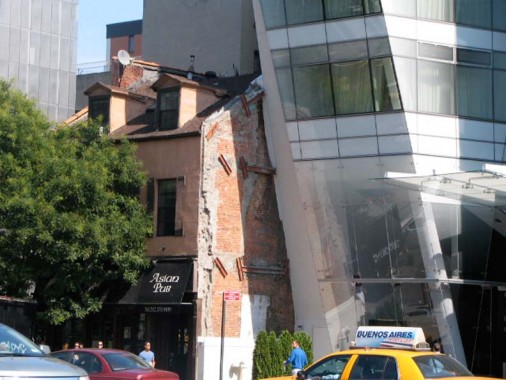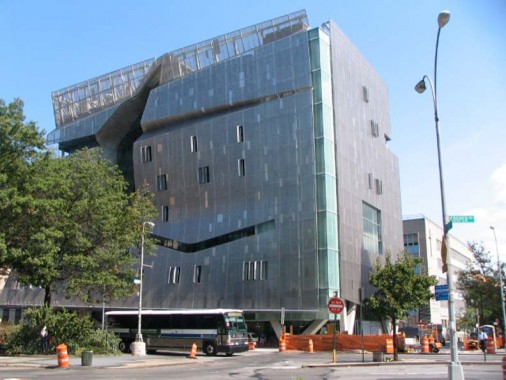Along with Williamsburg and the Times Square area over the past decade, Cooper Square, the junction of the Bowery, 3rd and 4th Avenues and Astor Place, is one of NYC’s key locations for rapid, break-neck change over that time — as has been The Bowery itself. The Bowery has worn many guises — from NYC’s entertainment capital to skid row shrouded by a vanished el to the capital of lamp and kitchenware discounters to the epicenter of luxe living with gleaming towers now rising along its length. After an afternoon of surveying Bleecker Street for an upcoming page, I found myself lurching along The Bowery, marvelling at the contrast between the 19th Century and the 21st — for here, it seems, the city seems hellbent on getting rid of all the buildings from the 20th!
The Bowery has always been a staple of Forgotten NY musings — I walked the entire route from Chatham Square to Cooper Square in 2005, well before the latest round of pleasure palaces was built thereon, when buildings like McGurk’s Suicide Hall were still standing — and again in 2006, after the new regime had begun to take hold. Even then the difference in one year was staggering. I stopped in Cooper Square in 2007 when a demolition afforded the casual walker some unusual perspectives.
The new Bowery towers over the old one. (I can’t capitalize the N, because there used to be a street called New Bowery, an extension of the Bowery below Chatham Square, now called St. James Place.) As always I turned to Jim Naureckas’ New York Songlines to guide me through contemporary Manhattan scenes I haven’t caught up with yet — Jim meticulously updates his pages. LEFT: this is the Bowery Hotel at the SE corner of East 3rd Street, a building Jim praises as one of the few new developments in the area that attempts to match rather than mock the architecture of its historic neighborhood–and quite successfully, I would say. It seems to be a bit too tall for that, and that windowless tower is sort of weird. Till just recently, all the hotels on the Bowery were single room occupancy, and there are still a couple of those left!
RIGHT: 52 East 4th towers above the old site of the legendary Five Spot jazz club on the NE corner of Bowery and East 4th. It’s a skinny luxury tower designed by controversial architect Robert Scarano, with interiors by Andres Escobar. Truly striking contrast between the low-rise 19th Century buildings and the 15-story luxury residences.
The Cooper Square Hotel seems to be NYC’s answer to Sir Norman Foster’s London Gherkin. It has also been likened to a shark fin. The luxury hotel, designed by Carlos Zapata, began rising in 2007.
From the beginning, residents in adjoining buildings were wary of the drinking establishments planned just inches from their windows. And, when the bars materialized, they vehemently protested them.
A holdout tenement, 35 Cooper Square, constructed in 1825, forced the hotel developers to build around it, cladding it in the same grey-white exterior as the rest of the building, at the right in photo above. The small dormered building, though, just to the north, still hung in there in 2009. It was the former home of radical poet/dramatist Amiri Baraka.
The building lost its fight to survive and was demolished in early 2011.
The new Cooper Union academic building on Cooper Square between East 6th and 7th Streets is perhaps the most radical design in the square, by Thom Mayne, founder of the LA design group Morphosis. NY Times architecural critic Nicolai Ourousoff gave Mayne’s hall a passing grade:
He is not a finicky designer; you don’t look to his work for refined details. He tends instead to extract beauty from the crudest industrial materials: raw concrete, steel I-beams, metal screens. The connections between materials are always clearly expressed, never smoothed over, so that you can feel the memory of the workers’ hands. It is what makes his buildings — like the Diamond Ranch High School in Pomona, Calif. — so approachable.
Give me the 1850s. The classic Cooper Union building still anchors Cooper Square as it has done since 1859. The school was founded by polymath Peter Cooper, who laid the first transatlantic cable, ran the first successful railroad, and was the first producer of edible gelatin (the father of Jell-O). The school’s great hall was where Abraham Lincoln launched his presidential campaign; other speakers have included Mark Twain, Frederick Douglass, Susan B. Anthony and presidents Grant, Cleveland, Taft, Theodore Roosevelt, Wilson, Clinton and Obama.
The 1867 Metropolitan Savings Bank building at East 7th and Cooper Square survives as a church.
page completed September 10, 2009

